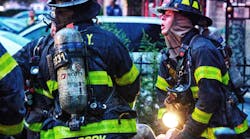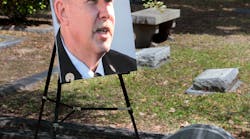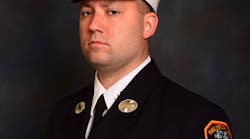We are pleased to announce the newest honorees in our Firehouse® Magazine Heroism & Community Service Awards program and take pride in highlighting the bravery of these outstanding individuals. We recognize the judges: Chief Mark McLees (ret.) of the Syracuse, NY, Fire Department; Chief Timothy J. Scranton of the Beverly Hills, CA, Fire Department; and Deputy Chief William Goldfeder of the Loveland-Symmes, OH, Fire Department. We also thank retired FDNY Rescue 1 Firefighter Paul Hashagen, who administers the program.
For this year’s program, we teamed the firefighters together who worked at the same incident. The judges scored each individual firefighter separately. The scores (circled numbers) reflect those the judges picked from the highest degree of difficulty in descending order, in their judgment. Chief McLees discusses this year’s program in the April “Firehouse® Magazine Insider” at Firehouse.com/podcasts.com/podcasts.
1. Ex-Chief John Curley
Bellmore, NY, FD Engine 2
On Nov. 12, 2012 at 7:40 A.M., Ex-Chief John Curley and his son were in a fire department pickup when a report of a house fire, possibly with people trapped, was released. Curley was the first to arrive. A two-story, high-ranch-style home had heavy fire from front to rear on the exposure-4 side. As Curley approached the scene, there was screaming coming from the other side of the street. He asked if everybody was out and was told the mother was still inside. The 61-year-old son, covered in soot, was trying to place a six-foot ladder on top of a 5½-foot-tall file cabinet. Curley told him to hold the cabinet while he jumped on top of it and placed the ladder against an air conditioner under the bedroom window. He climbed up the ladder, ripped out the screen and broke several panes in the window, in the process burning his fingers.
Heavy, black smoke began to vent. Curley could see the bed and reached in; the sheets moved freely. Curley thought she might be on the floor. Fire had already burned the top two feet of the bedroom door. He could make out what appeared to be legs lying on the floor. Curley climbed over the air conditioning unit and crawled to the unconscious 92-year-old woman. He lifted her up and carried her to the bed, then went to the window for some air. He yelled to his son and an arriving chief that he was going to need help. Curley lifted her halfway out the window on top of the air conditioning unit. Fire was rolling across the ceiling and his ears and head were starting to burn. He chose to climb over the woman and back onto the ladder. His son, chief and two Nassau County police officers were holding the file cabinet and legs of the ladder which were beginning to slide. The woman survived with serious injuries.
2. Lieutenant Thomas G. Woods
FDNY Ladder 154
On Oct. 29, 2012, portions of the Northeast were struck by Superstorm Sandy, the largest Atlantic hurricane on record measured by winds spanning 1,100 miles. Winds of 110 mph and a storm surge hit the New York City area. In the Rockaway community of Queens, because of the storm surge and tidal current, the Atlantic Ocean met Jamaica Bay across the 1,500-foot-wide peninsula. Streets were flooded and rising by the minute. The sea of water, high winds and loss of power forced neighbors to the upper floors of the homes. Lieutenant Thomas G. Woods lived on Beach 130 Street and was off duty. He could see flames from building fires about two blocks away. The 60-mph sustained winds were driving flames toward his street.
Dressed in a wetsuit, Woods tried to use a garden hose to extinguish embers that were covering his and his neighbor’s homes. The corner building, a landmark restaurant, was starting to burn. His neighbors were unable to navigate the high waters and were calling for help. Using a surfboard, he assisted a woman and a dog into a kayak and pushed them away from the fire, then led five more people to the safety of another home. The fire was burning multiple homes on Beach 129 and Beach 131 streets. Some of the homes on Beach 130 Street were beginning to ignite. Woods had to move everyone, including his family, to safety a few blocks away.
Using anything that could float, Woods organized a water-removal rescue of all these people 1,000 feet away. The journey was filled with floating obstacles, surging ocean water, driving rain, downed trees, utility poles, assorted debris and, in some cases, floating cars and boats. All the people were exposed to the fires from multiple buildings. Keeping the group together while covering the distance of six blocks under these conditions took about one hour; normally, it would take five minutes. He deposited the group at his brother’s house at Beach 135 Street.
Returning with his son, he found another neighbor. Sixteen homes on Beach 130 Street were now on fire, including Woods’ home. They spotted a retired FDNY neighbor on a porch roof with three couples trying to assist. They returned to Beach 135 Street with the entire family. Enroute they spotted a couple in their 80s on a porch roof. Woods brought them three more blocks to safety. Twenty-five individuals were rescued from the surging water and structural fire that eventually involved 32 buildings.
3. Firefighter James Doyle
Chicago, IL, FD, Engine 59
On Feb. 18, 2012, at 6:56 A.M., Truck 47 responded as the second truck to a still alarm. While enroute, the alarm was upgraded to a still and box alarm reporting people trapped on the third floor. Firefighter James Doyle was ordered to search the third floor. He climbed the aerial ladder of Truck 22. Despite a heavy volume of heated smoke Doyle was able to gain entry through a third-floor window. Once inside, while conducting a primary search, Doyle located an unresponsive 35-year-old male. Doyle had to raise the victim up and through the window of the third floor onto the aerial ladder. Seconds after Doyle began his descent on the ladder, carrying the victim, the apartment from which they had exited became heavily involved with fire. Doyle continued down the ladder and transferred the man’s care to Ambulance 31.
4. Past Chief Albert J. Jacoby
Florence Township, NJ, Fire District #1
On April 8, 2012 at 2:06 A.M., the Florence Township fire and police departments were dispatched for a report of two occupants trapped in a structure fire. Five occupants had been inside the dwelling at the time of the fire. Upon his arrival, Chief Keith Scully confirmed a working fire. One occupant fell or jumped from a second-floor window when fire vented from the window underneath. A woman was on a roof overhang when fire vented underneath her. She jumped to the ground. Upon arrival of Tower 4015, Past Chief Albert J. Jacoby was assigned to search the second floor. A handline was stretched upstairs. Jacoby and Firefighter Chris Perlingiero were the only members to make it upstairs. At the top of the stairs they faced limited visibility and high heat. Inspection holes were made in the ceiling. Fire was visible in front of and behind their position. Jacoby left the line to make a rapid search while Perlingiero protected the stairway. Jacoby located and removed an unconscious child. Both firefighters left with the child and initiated care with EMS. During the search, Jacoby’s turnout coat, helmet, bunker pants, SCBA, hood and radio sustained heat damage. The firefighters risked a lot to save the life of a child.
5. Lieutenant Marc C. Hickson
Lawrence, IN, FD
On Nov. 12, 2012 at 11:10 P.M., an explosion rocked the Richmond Hills subdivision of Indianapolis. Lieutenant Marc C. Hickson was awakened by a loud bang and a large swish of air. His garage door was off the hinges. Outside, he saw absolute destruction. Numerous homes were on fire and several had major damage. It appeared there had been some type of explosion affecting the neighborhood.
Hickson and a neighbor entered a house that was heavily damaged and on fire. They found a man covered by debris. As they removed the man, Hickson heard a voice. It was a woman who was buried under the rubble with only her head and one of her hands showing. There was a large hole above where the woman was trapped and fire was advancing on their location. The woman said she had been sitting in a recliner on the second floor when the explosion ripped a hole in the floor and now she was in the kitchen on the first floor. Drywall, wood, roofing material and debris were removed.
An officer from Indianapolis Engine 63 observed Hickson, who said he needed a handline for protection. After several grueling minutes, they were finally able to remove the woman. She stated her two children were unaccounted for. Hickson assisted another firefighter advance a hoseline. Due to no gear and increasing heat, Hickson made his way outside. The children had made it out prior to Hickson’s arrival. A total of 80 homes were damaged, with 33 needing to be demolished. Two people were killed. Three people were charged with blowing up a house to collect the insurance money.
6. Firefighter Christopher T. O’Brien
FDNY, Ladder 56
At 3:16 A.M. on Aug. 1, 2012, Ladder 56 responded to a reported fire with people trapped. Heavy fire was venting from a top-floor window. A woman was screaming that her children were trapped in the apartment.
Firefighter Christopher T. O’Brien donned his facepiece and crawled 50 feet down the smoke-filled hallway. He was forced to the floor because of the high heat condition caused by fire rolling out the first room on the right. O’Brien crawled under the flames and down the hallway, hearing a moan. Following the sound, he found an unconscious victim. He began dragging the severely burned 150-pound victim 20 feet to the door. The victim’s clothes had been burned off. With tremendous physical effort, O’Brien was able to get past the fire and reach the apartment door, where the victim was given to other members for treatment.
7. Firefighter Michael Piccolo
Chicago, IL, FD, Tower Ladder 21
On June 26, 2012 at 11:10 P.M., Engine 112 and Tower Ladder 21 were dispatched to a still alarm. While enroute, the address was changed. Upon arrival, there were three 2½-story frame structures well-involved. The middle structure was fully involved and the building to the right had fire on the first and second floor.
Tower Ladder 21 was alerted by neighbors of a missing man in the building to the left of the main fire building. Fire had communicated to the first and second floors of that dwelling. The volume of fire required the use of deck guns from Engines 112 and 78. Firefighter Michael Piccolo searched the second floor for the reported missing man.
Braving heavy smoke and fire, Piccolo reached a rear bedroom and found the unconscious male in his bed. Piccolo carried the victim to safety through the extreme heat and thick smoke conditions to the outside and began patient assessment. This rescue was described by Deputy Fire Commissioner John McNicholas: “Witnessing many rescues in my 34-year career, the efforts of Firefighter Piccolo rank among the best I’ve seen.”
8. Lieutenant John Silva
Chicago, IL, FD, Truck 42
On June 26, 2012, at 5:20 A.M., units from Battalion 23 responded to a still alarm. While enroute, the alarm was upgraded to a still and box alarm with reports of people jumping. Upon arrival, heavy fire was visible on the third and fourth floors of a four- story, ordinary-construction courtyard building.
Two civilians were screaming to be rescued from a one-story roof. Two occupants had climbed out a fourth-floor bathroom window and were now clutching the upper cross brace of a utility pole over 30 feet in the air. Heavy smoke was now emitting from the window they had exited. The fire had escalated to a third alarm and additional ambulances were called.
Truck 42 arrived and laddered both sides of the building to rescue civilians. Lieutenant John Silva cautioned his company about high-power electric lines, and then he climbed to the top of a utility pole through a maze of live electrical, telephone and cable lines feeding the area. As fire erupted from the window, Silva calmed the civilians and got them orientated onto the ladder through now-zero visibility. One by one, he guided them down through the maze of wires and cables to safety. Once the rescues were completed, Silva and his company continued with interior searches and fire containment.
9. Firefighter Robert J. Roschbach
FDNY Ladder 83
On Feb. 8, 2012, at 12:50 P.M., Ladder 83 arrived as the first-due truck at a house fire. Heavy, black smoke and fire were visible venting from the second floor of a dwelling. There was a heavy fire condition on the first floor. Fire was rolling across the ceiling toward the rear of the apartment. Firefighter Robert J. Roschbach advanced past the main body of fire toward the rear in high heat and zero visibility. Roschbach crawled 20 feet where he encountered the door to a bedroom. He entered the room, found the bed and swept his arm across the top of it. He located a non-breathing victim. He dragged the victim onto the floor and back the 20 feet down the hallway while fire burned overhead. He exited the apartment and past the engine still waiting for water. The victim was given CPR and was transported to a hospital with burns.
10. Firefighter Robert F. Andersen, FDNY, Rescue 3
11. Firefighter Patrick J. Hickey, FDNY, Rescue 3
12. Firefighter Kevin McCabe, FDNY, Engine 48
On April 14, 2012, at 1:14 P.M., units were being dispatched to a fire involving a three-story wood-frame multiple-dwelling housing a ground-floor church and apartments above. Heavy fire and smoke had extended to exposure two, a two-story brownstone. Firefighter Robert F. Andersen had been sent to monitor conditions with a thermal imaging camera. He found fire in the walls, and then a heavy piece of ceiling fell on Engine 48. He surmised that fire was traveling in this plenum.
While operating with Firefighter Patrick J. Hickey and Engine 48 in zero visibility and increasing heat, the second and third floors suddenly collapsed. Andersen was knocked off his feet and his thermal imaging camera and flashlight were ripped from him. Hickey was knocked to his knees, partially buried. Andersen crawled over and uncovered Hickey. Firefighter Kevin McCabe and the others heard several Maydays. Engine 48 opened their line to cool the heavy fire now burning.
Firefighter Dodwell, who had the nozzle on the second floor, rode the collapse down when the burning roof and second floor fell. He transmitted that he was trapped, burning, running out of air and needed help. Andersen followed the screams and saw Dodwell’s hand. McCabe saw his boot sticking out of debris about five feet above the ground. McCabe frantically used his hands to remove debris. With the building being unstable and fire burning all around them, Andersen worked on one side and Hickey on another as McCabe removed debris. Andersen grabbed Dodwell’s mask strap and turned him. Hickey reached Andersen’s position and lifted him out of the void.
13. Firefighter Michael J. Shepherd
FDNY, Squad 41
On March 22, 2012, at 7:54 A.M., Squad 41 responded to a building collapse with people trapped. Before the Squad’s arrival Battalion 16 confirmed the collapse of a four-story building under demolition. Upon arrival, three workers were reported trapped. One was in the process of being removed, the next was still trapped and the third was unaccounted for. Firefighter Michael J. Shepherd entered a void created by a lean-to collapse. Only the mouth and nose were exposed of the victim. The rest of his body was buried and pinned under collapsed, but intact brick wall sections, concrete and metal. Shepherd crawled and shored as he went using wood and other loose debris to quickly stabilize the one ton piece of concrete above him. Wedges, 4x4s and struts were requested. Shepherd continued on and took the victim's vitals. With the help of other firefighters, the intact brick wall was kept from sliding, enabling the wall to be broken apart and the worker freed.
14. Lieutenant John Maes
North Metro, CO, Fire Rescue District, Crew 63
On Feb. 23, 2012 at 4:19 A.M., units responded to a report of domestic violence in Northglenn, CO. A suspect had been assaulting his wife when he re-entered his home. Firefighters noticed a flash of fire through a front window and requested a full-structure response. The assault victim called police and was screaming that her husband was going to kill her children inside the house. Police officers trying to get inside the front door encountered a barricaded front door and entry door from the garage and they started to break down the door.
Firefighters stretched two handlines inside. They encountered a large body of fire on the stairs to the second floor. They were told two children and a male suspect were upstairs. Apparently, various accelerants were spilled all over the stairs and an outdoor grill was placed at the base of the stairs. Firefighters extinguished the main body of fire, then preformed a primary search on the second floor, where there was heavy smoke. Firefighter Hamilton located an unconscious adult victim on a bed in the master bedroom. A lighter was still in his hand and a weapon was nearby. Firefighter Brereton located an unconscious 18-month-old child with an obstructed airway caused by smoke inhalation. He cleared the child’s airway and removed the child to paramedics.
Lieutenant John Maes entered a back bedroom with zero visibility. Feeling his way, he found an unconscious 5-year-old girl who had suffered burns across 60% of her face and body. A large unconscious dog was located and removed to the exterior. Firefighters were able to provide two innocent children a chance at life – both children are out of the hospital despite their significant injuries.
15. Firefighter/Paramedic Robert Davidson
Orange County Fire Authority, CA, Station 20
On Jan. 20, 2012, at 12:15 P.M., Firefighter/Paramedic Robert Davidson was off duty and on Interstate 15 on the Cajon Pass in San Bernardino County. He and Firefighter Craig Ritter from Fountain Valley Fire Department saw an accident in which a vehicle hit a large roadway sign and burst into flames. Davidson pulled off the road 100 yards away.
As they were about to exit their vehicle to assist, another vehicle struck the back of Davidson’s car at a high rate of speed. The car was pushed 20 feet off the road. Davidson went to assess the driver in the first accident. Ritter tended to the driver of the vehicle that struck them. The driver of the first vehicle had significant injuries and was immovable due to passenger space intrusion and being pinned inside. There was active fire coming from the engine compartment and was lapping up and onto the trapped victim. Davidson broke the windows and yelled to others to get extinguishers from anywhere possible. Eight extinguishers were used prior to the fire department’s arrival. The victim received major burns in addition to injuries from the crash. As fire crews were performing extrication Davidson remained inside the vehicle to maintain cervical stabilization as needed.
16. Firefighter Christopher Lynch
FDNY Ladder 2
On Feb. 21, 2012, at 2:07 P.M., Ladder 2 responded first-due, normally third-due to a phone alarm for a fire in a 20-story fireproof multiple dwelling. Smoke was issuing from the second floor. A full residential high-rise assignment was requested. The ladder company entered the apartment under dense smoke and zero visibility. The fire had engulfed the living room and the heat increased dramatically. Access to most of the apartment was blocked by the extreme heat.
Firefighter Christopher Lynch ducked under the heat and flames and crawled past the fire to the only doorway that gave access to both bedrooms in the apartment. Lynch called for a 2½-inch handline. Lynch found an unconscious victim lying on the floor in the rear of the bedroom. Any escape via a rear window was impossible due to heavy-gauge window bars blocking the window. Lieutenant McCormack made his way to Lynch and helped carry the victim to the public hallway.
17. Firefighter Dale Fields
Chesterfield, VA, Dept. of Fire and EMS
On July 7, 2012, at 7:58 P.M., Firefighter Dale Fields was off duty and launched his personal fishing boat in the James River. He noticed a boat a quarter-mile mile away in the middle of the river on fire. A pleasure boat was heavily involved and free-floating in the river. Several individuals were swimming to shore. Two people were struggling to stay afloat.
Fields immediately entered the water secured the first victim and swam to his boat which began to float down the river holding the victim above the water line. Fields brought the victim to shore saving his life. Fields returned to the site. He could not find the second victim. He marked the spot where he last saw him using an anchor, rope and buoy. Still exhausted from the first rescue, Fields made four separate dives into the murky fast-moving water to locate the second victim. Unable to locate the person he returned to the boat landing. He gave information to the responding Scuba Team Rescue members. Fields placed his life on the line with no equipment or backup to save one person and numerous attempts to save another.
18. Paramedic In Charge John Wodzyisz
19. Fire Paramedic Sergio Moreno
Chicago, IL, FD
On May 24, 2012 at 6 P.M., Ambulance 56 responded to a person in the water. There were high winds and temperatures in the 50s at the Chicago Lake Front; waves were crashing the break wall. A crowd signaled the ambulance. The address was corrected and Ambulance 56 provided instructions to incoming units. Two civilians were hanging on the break wall about 70 to 80 feet out into Lake Michigan.
With units being redirected and still responding, and with the civilians in clear and imminent danger, Paramedic in Charge John Wodzyisz and Fire Paramedic Sergio Moreno, without protective flotation devices or water-rescue equipment, dove into the frigid waters of Lake Michigan. Braving the high winds and waves, the paramedics swam along the break wall and secured both civilians. They brought them to the inland shoreline where they were assisted by arriving fire companies.




![Raymond Chiozza 10 7 20 Memphis Sr Apt Comm Pic 1[22] Raymond Chiozza 10 7 20 Memphis Sr Apt Comm Pic 1[22]](https://img.firehouse.com/files/base/cygnus/fhc/image/2022/09/Raymond_Chiozza_10_7_20_Memphis_sr_apt_comm_pic_1_22_.631e983b5666a.png?auto=format,compress&fit=crop&q=45&h=139&height=139&w=250&width=250)
